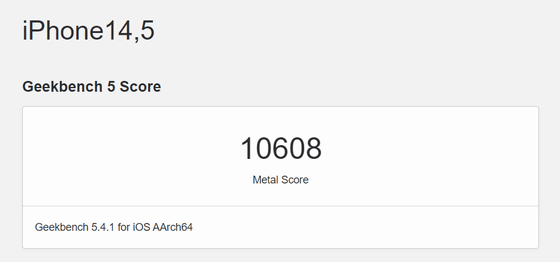The GPU performance of the iPhone 13 SoC 'A15 Bionic' is clear, and the difference in GPU performance between the 13 and 13 Pro is also clear

The iPhone has different SoCs for each series, but for example, the iPhone 12 series all have the same SoC
Additional Benchmarks Reveal A15 Bionic Performance Improvements in iPhone 13 and iPhone 13 Pro --MacRumors
https://www.macrumors.com/2021/09/15/a15-geekbench-cpu-gpu/
New iPad Mini Has Downclocked A15 Chip Compared to iPhone 13 --MacRumors
https://www.macrumors.com/2021/09/16/ipad-mini-downclocked-a15-chip/
It is reported that the benchmark software Geekbench has registered a benchmark score that seems to be from the iPhone 13 series. As for the CPU benchmark score, the single core performance increased by about 10% and the multi-core performance increased by about 20% compared to the previous series iPhone 12, so it was pointed out that 'it may not have achieved such a big performance improvement'. rice field.
Following this, a new discovery is the Metal score, which is an index for measuring GPU performance. In addition, probably because the iPhone 13 series is the timing before the release, it is registered as 'iPhone 14' on Geekbench. The Metal score that seems to be that of this iPhone 13 is '10608', which is about 15% higher than the Metal score of the iPhone 12 equipped with A14 Bionic.

In addition, the Metal score that seems to be that of the iPhone 13 Pro is also registered, and the score is '14216', which is considerably higher than the score of the iPhone 13. The number of GPU cores is different from 4 cores on the iPhone 13 and 5 cores on the iPhone 13 Pro, so it is clear that this contributes significantly to the score opening.
According to the benchmark score registered in Geekbench, the CPU operating frequency of the A15 Bionic of the iPhone 13 series is '3.2GHz'. On the other hand, an unconfirmed iPad benchmark with a CPU operating frequency of '2.93GHz' is also registered, so it seems that this is the benchmark score of the new iPad mini. Since the iPad mini uses the same A15 Bionic as the iPhone 13 series, 'the iPad mini has the CPU operating frequency downclocked,' reports Apple-related media Mac Rumors. In addition, the A15 Bionic installed in the iPad mini will have the same GPU as the iPhone 13 Pro with 5 cores. In other words, the A15 Bionic is for the iPhone 13 with high CPU performance and low GPU performance, for the iPhone 13 Pro with high CPU performance and GPU performance, and for the iPad mini with low CPU performance but high GPU performance. There are three types of configurations.
In addition, from the strings included in the Xcode 13 beta, it is clear that the 2021 model iPad mini has 4 GB of memory, while the 2021 model iPad has 3 GB of memory, and the iPad mini Supports 5G, but does not support millimeter waves , MacRumors reports .

Related Posts:
in Mobile, Posted by logu_ii







